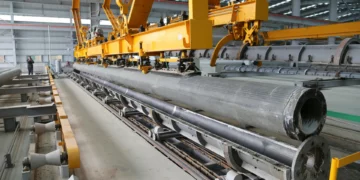Financial details of Google’s new plants were not revealed in the agreement.
A “world first” deal is signed by Google to buy energy from a fleet of mini nuclear reactors. To increase the rise in artificial intelligence, the nuclear reactors are used to generate the power needed.
The first to be completed by 2030 and the rest to finish up by 2035, the US tech corporation, Google, is said to have ordered six to seven small reactors (SMRs) from California’s Kairos Power.
Requiring huge volumes of electricity, Google hopes the deal will provide a solution which is low-carbon in order to power data centres. The company is owned by Alphabet and stated that a clean power source is provided by nuclear which can help Google to meet their electricity demands.
The tech company’s electricity demands were increased by cloud storage as well as the explosive growth of generative AI. To activate the nuclear plant for the first time in five years, Microsoft struck a deal to take energy from Three Mile Island in the last month. The most serious reactor meltdown in US history took place in March, 1979 in Pennsylvania.
In March, Amazon purchased a nuclear-powered data centre from Talen Energy in Pennsylvania.
Financial details of Google’s new plants were not revealed in the agreement. A total of 500 megawatts was agreed to be purchased by the tech company from Kairos. Founded in 2016 Kairos is building a demonstration reactor which is due to be completed in 2007 in Tennessee.
Google’s senior director for energy and climate, Michael Terrell stated that the company’s grid requires new electricity sources in order to support their AI technologies. These technologies were powering major scientific advances, driving national competitiveness and economic growth and improving services for customers and businesses. He also stated that the agreement aids in accelerating a new technology to reliably meet their energy needs. Further unlocking the full potential of AI for everyone.
The chief executive and co-founder of Kairos, Mike Laufer said that they are confident that the novel approach will help in the betterment of the project’s delivery on schedule and cost.
Subjected to regulatory approval, the transaction constitutes a vote of confidence in SMR technology. The smaller, factory-built power plants are intended to reduce cost overruns and delays that are common when building larger plants. However, sceptics claim that SMRs will be costly since they may not be able to attain the same economies of scale as larger facilities.
SMRs are reactors with a maximum output of 300 megawatts (MW) with a daily production capacity of more than 7 million kilowatt hours. However, some designs are larger than this, and the word is frequently used to describe factory-built modular facilities.
The output of larger nuclear power plants is typically known to be more than a gigawatts. The Hinkley Point C in Somerset which is the planned plant is expected to produce 3.2 GW which is enough electricity to power 6 million homes.
The companies are bidding in the UK to be selected by the government to take over the development of the tech company’s SMR technologies. While the country’s minister also aims to revive the country’s nuclear industry.
Rolls Royce SMR, one of the bidders experienced a significant boost in the last month. The Rolls Royce SMR was selected by the Czech government to build a fleet of reactors. The size of one of the SMRs of Rolls would be one tenth of a large power plant. The SMRs will also produce enough to power millions of homes.
It has been proposed that SMRs can supplement output from large-scale reactors as governments seek to transition away from fossil-fueled power generation. Proponents believe that they offer a more flexible approach to building new nuclear reactors since they require less cooling water and have a smaller footprint, allowing for a wider range of prospective site sites.
Environmental protesters and academics, on the other hand, have claimed that the technology has no demonstrated track record in the UK and that resources should be directed toward renewables like greater offshore wind.

















